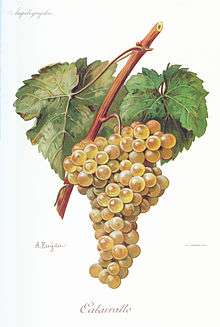Catarratto
| Catarratto | |
|---|---|
| Grape (Vitis) | |
 Catarratto depicted in L'Ampélographie | |
| Color of berry skin | Blanc |
| Species | Vitis vinifera |
| Also called | Catarratto Bianco Comune, Catarratto Bianco Lucido, Catarratto Bianco Extra Lucido, and other synonyms |
| Origin | Italy |
| Notable regions | Sicily |
| Notable wines | Salaparuta DOC |
Catarratto is a white Italian wine grape planted primarily in Sicily where it is the most widely planted grape. Overproduction in recent years has led to this grape being a substantial contributor to the European wine lake problem. Catarratto can make full bodied wines with lemon notes.[1] In the Etna DOC, the grape is often blended with Minella bianca and Carricante.[2]
Subvarieties and phenotypes
Catarratto exists in different phenotypes characterised by different pruinosity, i.e., different amount of whitish "bloom" on the grape berries. When this bloom is largely absent, the grapes give a more glossy impression. Catarratto Bianco Comune is characterised by a high amount of bloom, while Catarratto Bianco Lucido has a limited amount of bloom, and is more glossy or 'lucid'. The distinction between the two was first described by the Ampelographic Commission of Palermo in 1883, which gave them their names. They are also registered as two different grape varieties in Italy, but DNA typing has shown them to be identical.[3] Thus, the two phenotypes have resulted from massal selection of vines showing intravarietal variability of vines having been propagated vegetatively (by cuttings) from the same original seedling. A third variety or phenotype, Catarratto Bianco Extra Lucido, with a complete absence of bloom, was selected by B. Pastena in 1971 among Catarratto Bianco Lucido vines. This was also shown to be genetically identical with the other two, as was assumed by its origin.[3]
Pedigree
An Italian study published in 2008 using DNA typing (the same study that showed the three Catarrattos to be identical) showed a close genetic relationship between Garganega on the one hand and Catarratto and several other grape varieties on the other hand. It is therefore possible that Garganega is one of the parents of Catarratto, however, since the parents of Garganega have not been identified, the exact nature of the relationship could not be conclusively established.[3]
Synonyms
Catarratto is also known under the synonyms Castellaro, Cataratto Bertolaro, Catarratto Bianco Comune, Catarratto Bianco Extra Lucido, Cataratto Bianco Latino, Catarratto Bianco Lucido, Catarratto Bianco Lustro, Cataratto Bianco Nostrale, Cataratto Carteddaro, Catarratto Bertolare, Catarratto Bertolaro, Catarratto Bianco Latino, Catarratto Bianco Nostrale Catarratto Carteddaro, Cattaratto Commune, and Catarrato Lucido.[3][4][5]
References
- ↑ J. Robinson Jancis Robinson's Wine Course Third Edition pg 101 Abbeville Press 2003 ISBN 0-7892-0883-0
- ↑ J. Robinson, J. Harding and J. Vouillamoz Wine Grapes - A complete guide to 1,368 vine varieties, including their origins and flavours pg 640 Allen Lane 2012 ISBN 978-1-846-14446-2
- 1 2 3 4 ‘Sangiovese’ and ‘Garganega’ are two key varieties of the Italian grapevine assortment evolution, M. Crespan, A. Calò, S. Giannetto, A. Sparacio, P. Storchi and A. Costacurta, Vitis 47 (2), 97–104 (2008)
- ↑ Catarratto Bianco Comune, Vitis International Variety Catalogue, accessed on June 21, 2010
- ↑ Catarratto Bianco Lucido, Vitis International Variety Catalogue, accessed on June 21, 2010